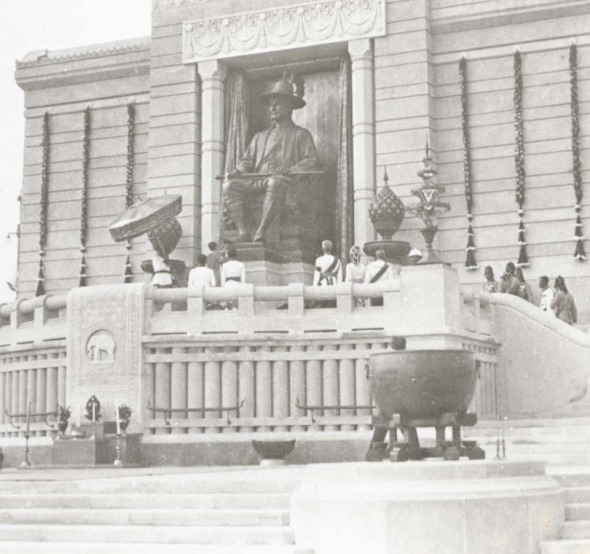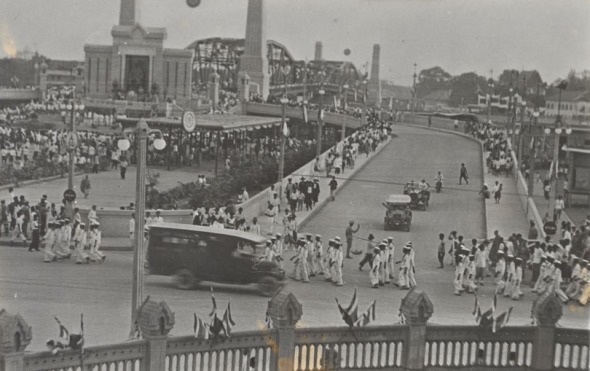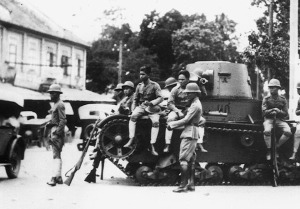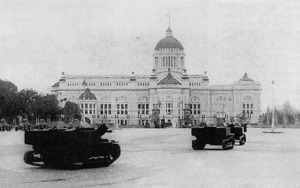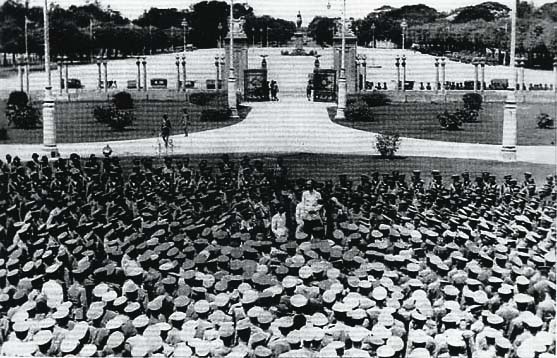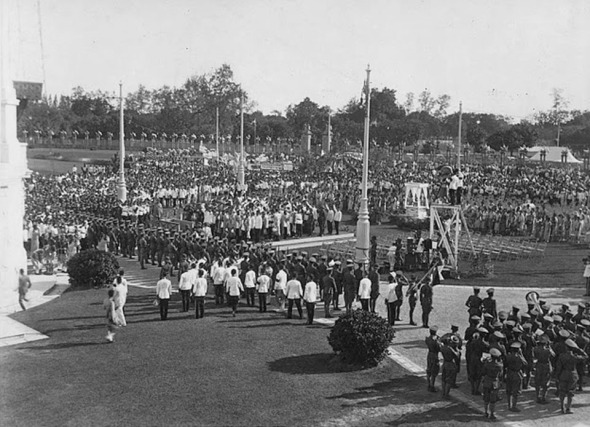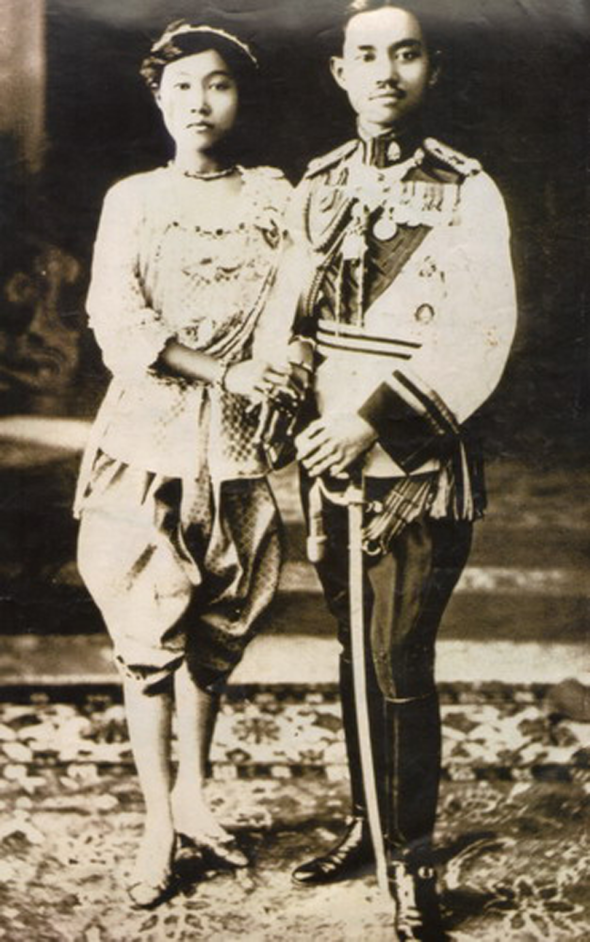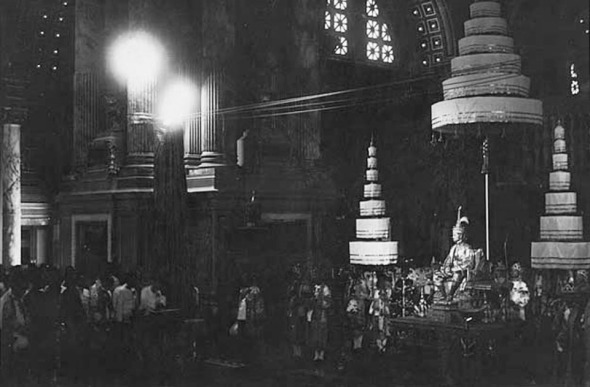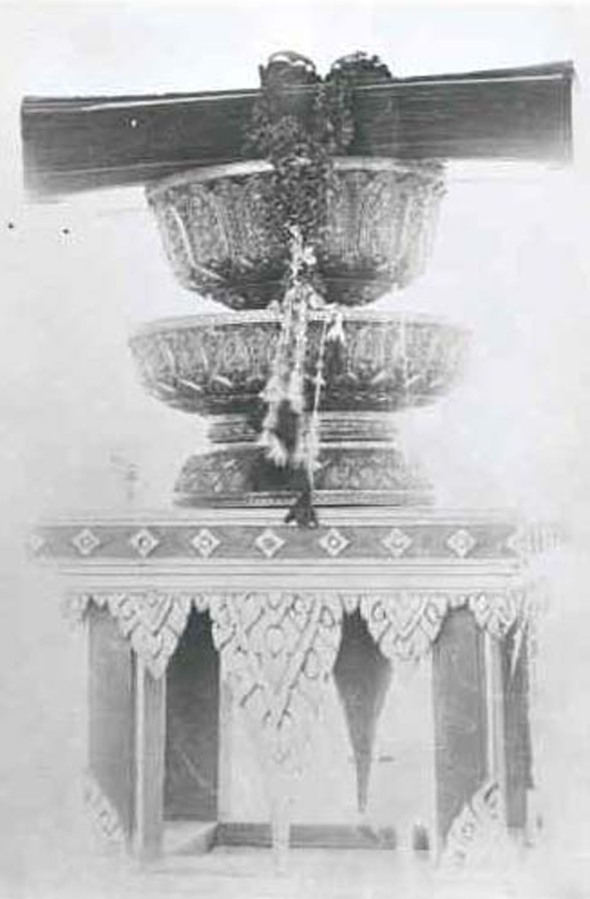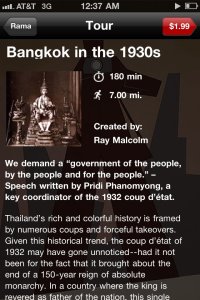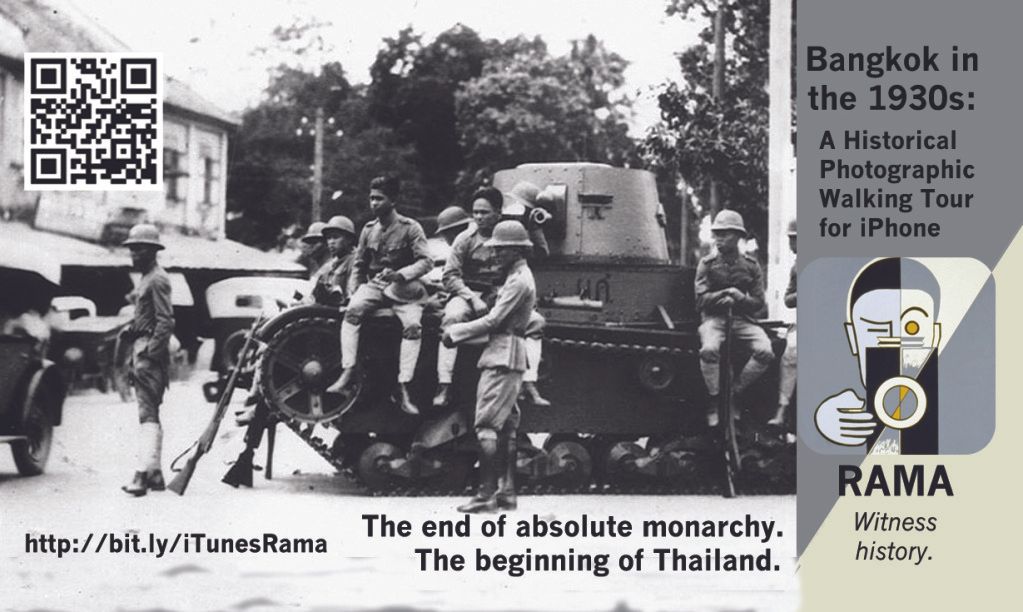Siamese Coup d’État of 1932: From Absolute to Constitutional Monarchy
Posted: June 6, 2011 Filed under: History | Tags: Annanta Sammakhom Throne Hall, Bangkok, Chakri dynasty, Corrado Feroci, King Prajadhipok, Krung Thep, Memorial Bridge, Rama, Siam, Thailand Leave a commentThe year 1932 marked a turning point in the history of Thailand. Faced with a failing economy, a reduced military budget, and cuts to civil service payrolls, a group of foreign-educated civilians and military leaders secretly began plotting the overthrow of the ruling princes of the Supreme Council. These princes practiced nepotism and greedily hoarded their personal wealth. In an attempt to ease the economic tension, King Prajadhipok proposed the levying of income taxes and property taxes but the Supreme Council opposed these policies, fearing that their personal fortunes would suffer. They instead made cuts to civil service and military spending, causing the Minister of Defense Prince Boworadet to resign, and angering civilians. The king himself was of a passive nature and allowed the Supreme Council to overrule him. He admitted his lack of financial acumen and publicly apologized for his failings:
“I myself do not profess to know much about the matter… if I have made a mistake I really deserve to be excused by the officials and people of Siam.”
In April of that year, Bangkok celebrated its 150th anniversary. Rama I founded the capital in 1782, after the fall of Ayutthaya. Legend tells how Rama I prophesised that his dynasty would last but 150 years. To honour the founding of the Chakri dynasty, the king had commissioned the building of a bridge to span the Chao Phraya River and a large statue of Rama I, which was sculpted by the resident Italian artist, Corrado Feroci. King Prajadhipok had promised to reveal his planned constitution during these celebrations. When the sesquicentennial passed without mention of a constitution, the People’s Party began to foment revolution.
Four senior army officers joined the Promoters after sensing the growing vibe of discontent among many of Siam’s young officers and civil servants. Chief among them was Phraya Songsuradet, who became the main tactician in plotting the coup and advised the Promoters to be more secretive to avoid official detection. The coup organizers held clandestine meetings in dimly-lit boardrooms to plan the overthrow of the ruling elites. Despite their precautions, word of the coup eventually leaked to the police. On the evening of June 23, 1932, the Director General of the Police made a phone call to Prince Paribatra – who was acting Prince Regent while the king was away at his seaside resort in Hua Hin – asking him for authorization to arrest the coordinators of the coup. The prince, recognizing many of the names on the list of conspirators, decided to delay the order until the next morning, a delay that would cost him bitterly.
In the early hours of June 24, 1932, civilian and military members of the People’s Party began to gather on the pavilion of Ananta Samakhom Throne Hall. A gunboat sailed up the Chao Phraya River and was positioned facing the residence of Prince Paribatra. Naval units arrived on the scene under false orders to suppress a Chinese uprising. Many of those gathered there on that fateful morning were unaware of the intentions of the People’s Party and there was a general air of confusion. Military units secured all strategic locations and the princes of the Supreme Council were arrested and imprisoned in the Throne Hall. Prince Paribatra was reputedly in his pyjamas when armed soldiers came to take him away; he was given no time to change his clothes. It was well known that Paribatra had strongly opposed the constitution and wished to put himself or his son on the throne in place of King Prajadhipok. Only one of the princes managed to avoid arrest. Prince Purachatra had been away at the Turkish baths in downtown Bangkok when a faithful servant came to warn him of the uprising. He escaped from Bangkok by train and disembarked in Hua Hin, where he informed King Prajadhipok of the state of affairs back in the capital.
When a large crowd had gathered on the pavilion of Ananta Samakhom Throne Hall, a speech was given by Phraya Manopakon (Mano) which strongly criticised the king and the ruling elites. The speech was written by Pridi Phanomyong, a French-educated radical who played a key role in organizing the coup d’état. Mano, standing on a podium on the pavilion of the Throne hall, read out the Manifesto of the People’s Party. In it, the king was accused of embezzling funds, nepotism and governing without principle. In the speech, the People’s Party invited the king to retain his position, but under a constitution which would strip him of all his theoretical powers. The king was given an ultimatum: if he did not reply, it would be taken as treason and the country would adopt a republican form of government. All this was broadcast over radio and supporters of the movement blanketed the capital with flyers and pamphlets. Despite the rousing speech, many of the onlookers remained noncommittal and waited to see the reaction of the forces that were being ousted.
Meanwhile, King Prajadhipok was at his seaside palace, Klai Kangwon, teeing off a game of golf when Prince Purachatra came charging onto the scene talking of revolution in the capital. The king took the news with aplomb and asked his wife, Queen Rambai Barni, to finish the game of golf while he went indoors to discuss the matter with Purachatra. Also staying with the king was Prince Svasti, Queen Rambai Barni’s charismatic father, who was well known for his wit and charm. The group nervously listened to the strongly-worded radio broadcast of the People’s Party and considered what course of action to take. At first, the possibility of fleeing the country was broached but when the king turned to his wife for a final answer, she decided the most honourable thing to do would be to return and face the music. Later in the day, they received a telegram from the People’s Party which contradicted the terms set forth in their Manifesto. In the telegram, they assured King Prajadhipok that if he did not want to remain on the throne, they would be happy to replace him with another prince. Soon after, a gunboat was dispatched to Hua Hin and the commander of the vessel went ashore to ask the King to return with him to Bangkok. He refused to board the gunboat and went instead by royal train.
King Prajadhipok and his entourage arrived in Bangkok late the next night and were met by a police guard who served as escort to the group. No military display was permitted at the Bangkok station and the People’s Party kept a respectful distance. Early the next morning, the king expressed his wish to meet with the leaders of the coup. Four members of the People’s Party were escorted to a room in King Prajadhipok’s palace where he was sitting behind a broad desk. He smiled and rose to greet them. “I rise,” he said, “in honour of the People’s Party.” In a country where civilians had once been obliged to prostrate themselves in the presence of the king, this significant moment was seen as a clear sign of King Prajadhipok’s willingness to agree to the terms of the People’s Party Manifesto. On June 27, 1932, King Prajadhipok signed the draft constitution, which stripped him of all his ancient powers. All the princes held captive were then released, all except Prince Paribatra, who was exiled to Germany for fear that he might stage a counter coup.
By the end of November of that year, the new government had drafted up a Permanent Constitution and it was formally signed by King Prajadhipok on December 10, 1932, thus ending 150 years of absolute monarchy.
To see more pictures from the 1932 coup d’état, visit my image blog, Siamese Visions.
Siam Tries A People’s Party – Article from Asia Magazine 1932
Posted: May 12, 2011 Filed under: History | Tags: Annanta Sammakhom Throne Hall, Bangkok, Chakri dynasty, King Prajadhipok, Siam, Thailand, the city of angels Leave a commentA very interesting article written by Clare McKelway —->Siam Tries a Peoples Party
New iPhone guided tour comes to Thailand
Posted: April 28, 2011 Filed under: News | Tags: Annanta Sammakhom Throne Hall, Bangkok, Chalermkrung Theatre, Democracy Monument, iPhone, King Prajadhipok, Krung Thep, Memorial Bridge, Rama, Rattanakosin Island, Siam, Thailand, the city of angels, The Grand Palace, Wat Suthat 5 CommentsFor the last few months I have been lucky enough to be part of something big in the world of iPhone apps. In early January of this year, I discovered a call for writers who “know Thailand” on craigslist and, deciding that I had nothing to lose, I sent out an email expressing my wish to take the job. I didn’t expect to get a reply and so when I got an email saying that I seemed like the ideal candidate, I was a pleasantly surprised.
Even more surprising was the assignment I was given: I had to write a “historical” tour guide. Did I have to travel through time? Not quite.
Rama – an app designed by New York-based Crimson Bamboo – is available on the iPhone and puts a unique spin on the role of tour guides. The app harnesses the power of GPS, archival photographs and storytelling to create compelling tours that not only direct you to intriguing locations, but also inform and entertain you. Rama offers guided tours in a number of cities throughout the world and is looking to add new tours in the near future. This tour is the first for Thailand.
“Bangkok in the 1930s” takes you through a decade of economic crisis, coup d’états, political intrigue and the birth of a new nation. The narrative is set against the backdrop of Bangkok’s most famous temples and palaces and the tour guides you to places such as the Annanta Sammakhom Throne Hall – where the People’s Party staged a coup d’état in 1932 and ousted King Prajadhipok (Rama VII).
If you’re planning a trip to Bangkok, this guided tour offers you the perfect opportunity to discover places that you may otherwise overlook, while learning about the country’s history in a compelling and interactive way.
“Bangkok in the 1930s” is available as an in-app purchase at $1.99 on Rama, an iPhone app found on iTunes: http://bit.ly/iTunesRama or through the developer’s website at http://www.crimsonbamboo.com.
